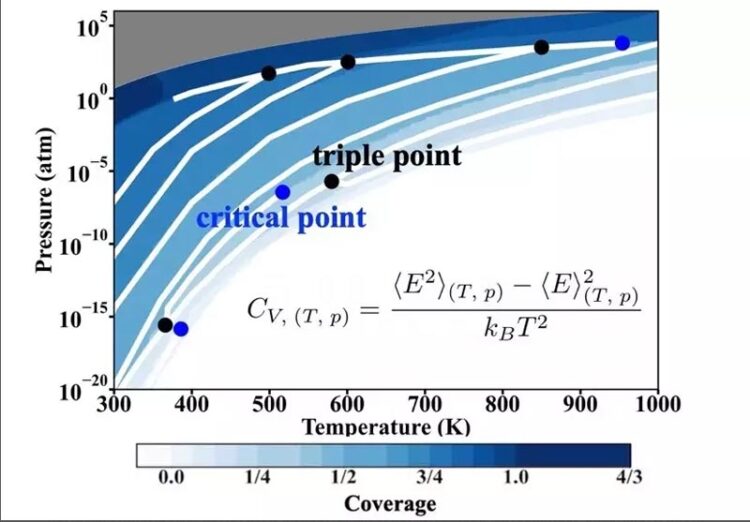Surfaces at realistic conditions

Phase diagram of the Si(100) surface in a D2 gas phase by REGC method including phase boundaries (white line) and triple points as well as critical points.
© FHI / Y. Zhou
Researchers at the NOMAD Laboratory at the Fritz Haber Institute have been engaged in describing how surfaces change in contact with reactive gas phases under different temperature and pressure conditions.
Researchers at the NOMAD Laboratory at the Fritz Haber Institute have been engaged in describing how surfaces change in contact with reactive gas phases under different temperature and pressure conditions. For this purpose, they have developed the so-called replica exchange grand canonical method (REGC). The results were published in the journal Physical Review Letters on 17 June.
“Replica exchange” means that there are many replicas prepared for the silicon surface in contact with different hydrogen atmospheres. These replicas exchange with each other during the simulation. “Grand-canonical” means that the silicon surface in each replica exchanges deuterium atoms or molecules with the deuterium gas reservoir it touches, eventually reaching equilibrium with the deuterium gas reservoir.
Knowledge of the morphology and structural evolution of material surfaces in a given reactive atmosphere is a prerequisite for understanding the mechanism of e.g. heterogeneous catalysis reactions and electrocatalysis due to the structure-property-power relationship. In general, the reliable tracking of phase equilibria is of technological importance for the reasonable design of surface properties. Phase transitions are indicated by singularities of a reaction function (e.g. the heat capacity). FHI researchers have addressed this challenge by developing the Replica Exchange Grand Canonical (REGC) method in conjunction with molecular dynamics. The approach not only captures the restructuring of the studied surface under different reactive conditions, but also identifies surface phase transition lines as well as triple and critical points.
The dissociative adsorption of molecular hydrogen on the silicon surface has become a crucial criterion in the study of adsorption systems and has important applications such as surface passivation. The REGC approach is demonstrated using a silicon surface in contact with a deuterium atmosphere. In the range of 300 to 1 000 Kelvin, the REGC approach identifies 25 different thermodynamically stable surface phases. Most of the identified phases, including some phase transitions between order and disorder, have not been observed experimentally before. It is also shown that the dynamic formation or breaking of Si-Si bonds is the driving force behind the phase transition between the experimentally confirmed adsorption patterns.
The REGC method makes it possible to combine traditional concepts of condensed matter statistical mechanics with state-of-the-art electronic structure calculations to predict stability phase diagrams of real systems. Furthermore, the approach has a significant impact on surface restructuring calculations in the field of surface science and is potentially relevant to a variety of important applications such as heterogeneous catalysis, electrocatalysis and surface segregation.
Journal: Physical Review Letters
DOI: 10.1103/PhysRevLett.128.246101
Method of Research: Experimental study
Article Title: Ab initio approach for thermodynamic surface phases with full consideration of anharmonic effects: The example of hydrogen at Si(100)
Article Publication Date: 7-Jun-2022
All latest news from the category: Physics and Astronomy
This area deals with the fundamental laws and building blocks of nature and how they interact, the properties and the behavior of matter, and research into space and time and their structures.
innovations-report provides in-depth reports and articles on subjects such as astrophysics, laser technologies, nuclear, quantum, particle and solid-state physics, nanotechnologies, planetary research and findings (Mars, Venus) and developments related to the Hubble Telescope.
Newest articles

NASA: Mystery of life’s handedness deepens
The mystery of why life uses molecules with specific orientations has deepened with a NASA-funded discovery that RNA — a key molecule thought to have potentially held the instructions for…

What are the effects of historic lithium mining on water quality?
Study reveals low levels of common contaminants but high levels of other elements in waters associated with an abandoned lithium mine. Lithium ore and mining waste from a historic lithium…

Quantum-inspired design boosts efficiency of heat-to-electricity conversion
Rice engineers take unconventional route to improving thermophotovoltaic systems. Researchers at Rice University have found a new way to improve a key element of thermophotovoltaic (TPV) systems, which convert heat…



